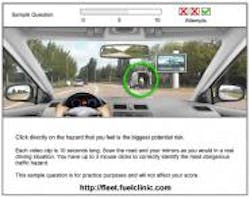“Any system which depends on human reliability is unreliable.” –Glib’s second law of unreliability
As you may or may not know, the Federal Highway Administration (FHWA) is putting the final touches on a long-term strategy in hopes to unveil next year to completely overhaul the motor transport “safety culture” in this country.
You can read more about this plan – entitled Toward Zero Deaths: A National Strategy on Highway Safety or “TZD” for short – in the news section on our website tomorrow; a 25-year long range effort partially modeled on a Swedish program dubbed the Vision Zero initiative that nation launched back in 1997.
While the FHWA’s TZD plan is very broad, one of its key components is vehicle safety technology – how to upgrade the systems within a car or truck to minimize the impact of human error on the highway.
At a traffic safety conference hosted by the Swedish embassy in Washington D.C. last week, Volvo Cars showed off how its new “pedestrian braking” system would work in terms of helping to reduce vehicle-pedestrian collisions, lowering both the fatality and injury rate such crashes produce.
Now, this technology nowhere near perfect yet, but it’s a key part of Volvo’s ambitious aim to have no one killed or injured in a Volvo car by 2020, according to Adam Kopstein, one of the company’s traffic experts. “We know that’s an ambitious goal and we also know that this isn’t far off, either, for 2020 is just two or three car models from now,” he added.
Another critical piece of technology within the FHWA’s “safety culture” change initiative is going to be the adoption of vehicle-to-vehicle (VIV) and vehicle-to-infrastructure (VII) systems. These technologies will allow for the greater collection and dissemination of data not only for better traffic flow management for motorists and freight carriers alike, but to help warn operators of safety issues ahead of their vehicles.
[Below, you can see how these technologies are expected to work based on tests done in Europe in the last several years.]
Patrick Magnusson from the Swedish Transport Administration told me that he believes VIV systems in particular could play a pivotal role for truck drivers. “One of the biggest challenges for commercial vehicle operators is that they cannot ‘see’ around the truck in front of them,” he explained. “With VIV systems, the truck ahead of them could communicate data directly back to their own vehicle automatically, such as if pedestrians are crossing the road or if there is a traffic accident ahead.”
Truckers, of course, are well familiar with many of the technologies the FHWA is closely investigating as part of its overarching “safety culture” strategy, especially in terms of “automatic braking” and vehicle stability control systems
Here, for example, is Meritor Wabco’s OnGuard system for commercial vehicles, which combines forward-collision radar with the braking system.
Bendix is another supplier that’s dalso eveloping an “automatic braking” systems of sorts as well, dubbed the “Wingman.” You can watch a short report on its capabilities below.
Yet at the end of the day, improving vehicle behavior on our highways falls to the driver: the human with their hands on the wheel. So being able to spot problem drivers is going to become far more critical in the future.
Many technologies are being deployed in this area now, as well. One example comes from Compendium Software Systems LLC, creators of the FuelClinic Fleet Systems. It just recently rolled out what it calls a “Hazard Perception Evaluation” or “HPE” test designed by AlertDriving to help fleet owners identify high-risk drivers, based on their ability to spot potentially dangerous situations that happen every day on our roadways.
Michael Bragg, Compendium’s president, said HPE is a predictive behavioral analysis tool not only identifies a fleet's high-risk drivers and provide specific targeted training modules to correct the individual deficiencies.
“This provides a key indication of the driver's propensity to be involved in a collision,” he explained. “Each evaluation includes a series of simulations as well as multiple-choice questions pertaining to the safe operation of a motor vehicle. The simulation section presents the driver with a view out the front windshield of a vehicle from the driver's seat, as well as rear-view and both side-view mirror perspectives, which captures the dynamics of driving in the real world.”
The assessment continuously evaluates a trainee's performance in six core areas, then assigns targeted training modules for each individual driver, maximizing benefit while reducing overall training time by providing a custom training program.
Bragg said this HPE system can cut collisions by an average of 30% to 40%, and up to as much as 63%, based on field tests done with fleets so far.
How that will play out more broadly in the motor vehicle world is still open for debate, but it’s an example of the expectations being placed on technology to make us humans better and safer drivers.
